
One of the most persistent agricultural pests in California is the destructive navel orangeworm, NOW for short. One of the quirks of pest biology is that it is not a pest of major concern to orange or other citrus growers.
It does feast heavily in almond, walnut and pistachio trees, leaving behind damage to tender hulls and husks that causes the nut to be downgraded or even discarded after harvest. Unless discouraged, the worm eats away at the nut’s protective covering from spring through summer. The nourishment it receives seems to encourage enthusiastic reproduction. So, if its first generation doesn’t spoil the ripening nuts the second, third or tenth generation will.
The state’s almond growers are embarking on a new offensive against the worm using a technique that has been effective with other pests in other crops. Environmental purists are sure to be delighted to learn that the warfare does not involve chemicals.
For the first time almond growers will be part of a widespread pest control method described as sterile male release. It starts in an insectary, a specialized facility where millions of male larva of the species are reared, even pampered, and carefully nourished to adulthood.
As they reach the adult stage millions of the healthy males are robbed of their ability to reproduce by receiving a sterilizing exposure of radiation. Soon after, they are released to fly above nut orchards, probably eager to employ the very talent they have been denied. Equally eager are females of the species lurking naturally in orchards below,
And this is when the concept strikes hardest and most effectively. If mating occurs it is only superficial, without the females being impregnated. They may boast to family and friends, hold early showers, even stock up with cute baby gifts, but birth will not occur. The process has had notable success in California. It was the mainstay of several pest control techniques enforced against the notorious pink bollworm 15 or more years ago.
The result was a declaration in 2018 that the pinkie, as it had become known, had been eradicated, opening the door to renewed widespread cotton production in the Central Valley.
Aware that the specialized insectary in Phoenix was fully capable of reactivation and production of millions of sterilized males daily, leaders of the pistachio industry in California and Arizona supported a program to release sterilized male navel orangeworm larvae above their orchards.
For reasons still being explored, the sterilized males seemed less enthusiastic than expected about mating with live females in the orchards below. After repeated efforts in a variety of conditions and adjustments in application and other conditions the program was abandoned.
More study is being done by researchers to determine why the NOW males didn’t want to do enough of what comes naturally. One possibility is that the dose of radiation they received at the insectary was too intense, resulting in a kind of sexual lethargy.
Almond growers are convinced that research efforts will lead to re-invigorated male NOW larva. It will take at least a full season to know if nature can be restored in the rarified air above the state’s 1.4 million acres of almond orchards., some too young to bear. Walnut growers are hoping that what works for almond orchards will work for them. And perhaps, success may bring the process back to pistachio orchards as well.
In the meantime, untold millions (or billions) of male NOWs are hoping the vasectomies they received by radiation are not without purpose. At least they were painless.








